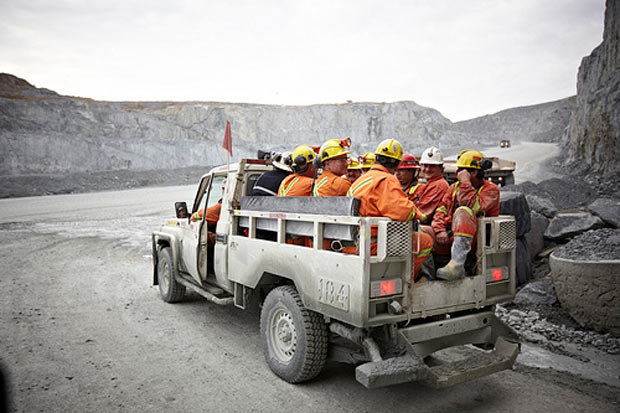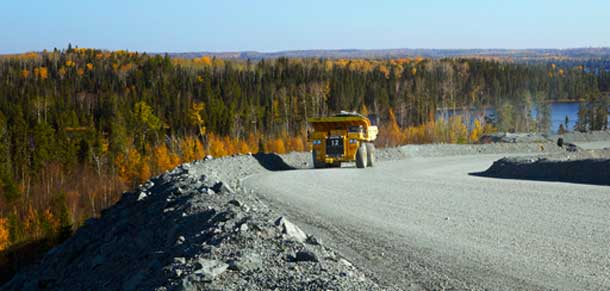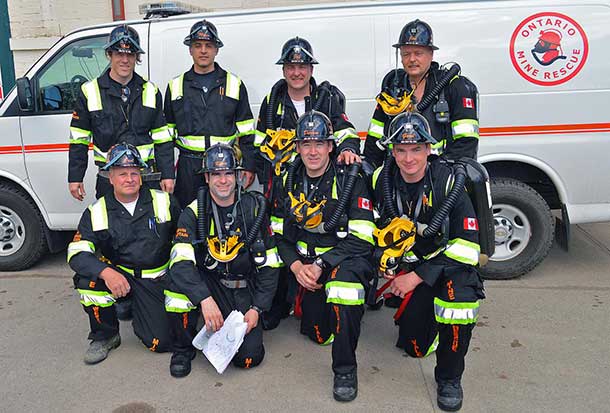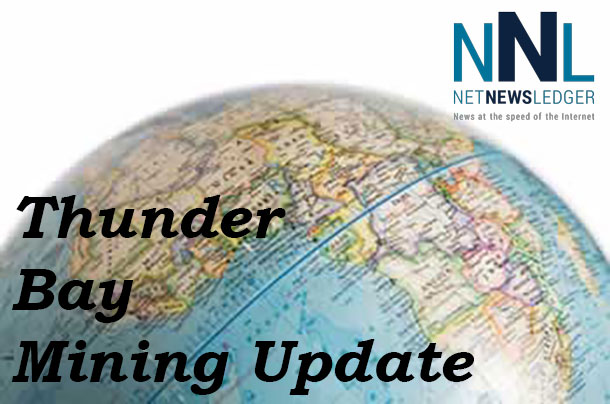
THUNDER BAY – BUSINESS – North American Palladium Ltd. (“NAP” or the “Company”) (TSX:PDL)(NYSE MKT:PAL) is pleased to announce fourth quarter drilling results from its 2014 Lac des Iles exploration program. Multiple intersections of palladium mineralization over significant core lengths are reported from both the Lower Offset Zone and the outcropping Powerline Zone.
Highlights
- New palladium intersections from the Lower Offset Zone below the 1065 meter mining level including:
- Drill hole 14-909 intersected 49.7 meters of 4.7 g/t Pd
- Drill hole 14-912 intersected 50.0 meters of 4.9 g/t Pd
- Drill hole 14-916 intersected 20.0 meters of 7.9 g/t Pd
- Drill hole 14-918 intersected 46.7 meters of 4.1 g/t Pd
- Additional high-grade palladium mineralization intersected at the surface outcrop known as the Powerline Zone with vertical depths from surface ranging from less than five to 70 meters, including:
- Drill hole 14-119 intersected 35.3 meters of 5.7 g/t Pd including 11.0 meters of 13.2 g/t Pd starting at a vertical depth of approximately 45 meters
- Drill hole 14-122 intersected 43.9 meters of 6.0 g/t Pd including 10.8 meters of 18.6 g/t Pd starting at a vertical depth of approximately 20 meters
- Drill hole 14-125 intersected 62.8 m of 6.4 g/t Pd including 25.8 meters of 13.9 g/t Pd starting at a vertical depth of approximately six meters
- Drill hole 14-126 intersected 62.2 m of 4.6 g/t Pd including 18.3 meters of 13.5 g/t Pd starting at a vertical depth of approximately six meters
An initial resource estimate for the Powerline Zone will be included in the Company’s next reserve and resource update.
“The encouraging results from the 2014 drilling campaign at Lac des Iles confirm the presence of significant mineralization in the Lower Offset Zone,” said Phil du Toit, President and Chief Executive Officer. “We continue to evaluate the implication of these results on life of mine extension opportunities for our preliminary economic assessment which is in progress. We are also very pleased with the results at the Powerline Zone, which justify further drilling in 2015.”
The Company’s Vice-President, Exploration, Dave Peck added: “The 2014 program resulted in a major refinement to the exploration model for the Mine Block Intrusion. New insights into the critical role of structural intersections in focusing palladium mineralization and base metal sulfides have opened up several new exploration targets on the mine property and on our regional greenfields properties. The high-grade palladium intersections in the Powerline Zone are the result of applying our new exploration concepts in areas that were previously believed to have limited potential for high-grade mineralization.”
Fourth Quarter and 2014 Annual Exploration Results
The 2014 Lac des Iles exploration program was completed in late December. Exploration drilling statistics for the fourth quarter of 2014 include:
- 35 holes and 14,792 meters in total, including 15 holes and 12,620 meters on the Lower Offset Zone and 19 holes and 1,965 meters on the near-surface Powerline target
Exploration drilling statistics for the full calendar year ending December 31, 2014 include:
- 66 holes and 36,309 meters on the Mine Block intrusion
- 39 holes and 33,415 meters on the Offset Zone including the Lower Offset Zone, the Upper Offset Zone and the Upper Offset southeast extension target
- 26 holes and 2,688 meters on the Powerline Zone
- One hole and 207 meters on other surface targets
A discussion of the fourth quarter exploration results is provided below with reference to selected assay results (Tables 1 and 2). Click here for access to extended assay results (Table 3) and supporting figures contained in the Appendix to this news release.
Lower Offset Zone Exploration
Selected highlights of the fourth quarter Lower Offset Zone drilling are provided in Table 1. Drill hole pierce points for the 2014 Offset Zone drilling program are shown in Figure 1.
Several holes drilled into the Lower-Central Offset Zone in the fourth quarter confirmed the continuation of this sub-vertical magmatic conduit to at least 1,400 meters below surface. Below this depth the conduit is disrupted by the recently recognized Camp Lake fault, which is the most significant of a series of parallel fault planes that mimic the orientation and displacement vectors of the Offset fault and occur at a regular spacing of approximately 200 meters within the Offset Zone structural block. Additional minor fault planes occur between these regular-spaced structures. The intensity of deformation and magnitude of displacement within the Offset Zone peaks at either end of the zone along the bounding Offset and Camp Lake faults. Movement along the Camp Lake fault is modeled to be approximately 200 meters of lateral displacement and 50 to100 meters of vertical displacement such that the Lower-Central Offset Zone conduit is believed to have moved to the west and upward on the south side of the fault. Definition of high-grade mineralization within and south of the Camp Lake fault remains a challenge given the current underground drilling platforms and increased deformation in proximity to the principal fault plane. 2014 drilling results indicate a general thinning of the deposit along strike to the north and south of the Lower-Central Offset Zone. However, the deposit remains partially open to depth to the north of the Camp Lake fault and is fully open along strike to the south of the Camp Lake fault.
Table 1: Selected drilling highlights for the Lower Offset Zone from the fourth quarter of 2014. Cu and Ni results are provided in Table 4 (Appendix). Average grades reported are weighted by individual sample core lengths. Interval assays represent measured core lengths. True widths are estimated to represent between 50-70% of the reported core lengths.
|
HOLE # |
FROM (m) |
TO (m) |
LENGTH (m) |
Pd (g/t) |
Pt (g/t) |
Au (g/t) |
|
14-909 |
678.00 |
727.70 |
49.70 |
4.65 |
0.34 |
0.33 |
|
including |
678.00 |
689.00 |
11.00 |
7.68 |
0.50 |
0.30 |
|
14-912 |
727.00 |
777.00 |
50.00 |
4.88 |
0.33 |
0.41 |
|
including |
737.00 |
746.00 |
9.00 |
11.83 |
0.74 |
0.86 |
|
14-913 |
821.78 |
834.75 |
12.97 |
4.26 |
0.30 |
0.23 |
|
14-914 |
939.00 |
954.00 |
15.00 |
4.59 |
0.35 |
0.39 |
|
including |
939.00 |
943.00 |
4.00 |
12.19 |
0.93 |
1.04 |
|
14-916 |
682.00 |
702.00 |
20.00 |
7.86 |
0.49 |
0.30 |
|
including |
687.00 |
695.00 |
8.00 |
15.23 |
0.87 |
0.40 |
|
14-918 |
772.30 |
819.00 |
46.70 |
4.13 |
0.32 |
0.32 |
|
including |
773.40 |
783.00 |
9.60 |
9.38 |
0.62 |
0.49 |
|
14-922 |
791.00 |
803.00 |
12.00 |
7.41 |
0.50 |
0.38 |
|
and |
810.00 |
817.78 |
7.78 |
4.95 |
0.28 |
0.46 |
Surface Exploration – Powerline Zone
Approximately 2,000 meters of surface drilling was completed on the Powerline Zone in the fourth quarter. Nineteen additional drill holes having average lengths of less than 100 meters were completed over a targeted strike length of approximately 125 meters. This drilling was a follow up on encouraging results obtained in the previous quarter (see the Company’s news release dated October 21, 2014). Highlights of the drilling are provided in Table 2. A map showing the location of the highest grade mineralization relative to the 2014 drill hole locations and surface infrastructure is given in Figure 2.
The Powerline Zone represents an outcropping, high-grade segment of the northernmost part of the Sheriff Zone in an area characterized by steeply dipping, east-trending mafic and intermediate dykes. The highest palladium grades observed in the Powerline Zone are hosted by varitextured gabbro and pyroxenite containing trace to minor amounts of disseminated sulphide. The mineralization appears to follow sub-vertical north-south structures as observed in the adjacent Roby hangingwall zone. Local deviations from this trend occur along the east-west dykes. The full extent of the high-grade Powerline Zone mineralization has not yet been determined.
Table 2: Selected drilling highlights for the Powerline Zone from the fourth quarter of 2014. Cu and Ni results are provided in Table 4 (Appendix). Average grades reported are weighted by individual sample core lengths. Interval assays represent measured core lengths. True widths are estimated to represent between 50-70% of the reported core lengths.
|
HOLE # |
FROM (m) |
TO (m) |
LENGTH (m) |
Pd (g/t) |
Pt (g/t) |
Au (g/t) |
|
14-106 |
40.10 |
46.00 |
5.90 |
4.59 |
0.37 |
0.13 |
|
14-119 |
37.00 |
72.25 |
35.25 |
5.68 |
0.37 |
0.13 |
|
including |
53.00 |
64.00 |
11.00 |
13.16 |
0.62 |
0.18 |
|
14-121 |
44.00 |
70.40 |
26.40 |
3.93 |
0.33 |
0.33 |
|
including |
46.00 |
48.00 |
2.00 |
12.34 |
0.83 |
0.78 |
|
14-122 |
21.08 |
65.00 |
43.92 |
6.01 |
0.32 |
0.16 |
|
including |
33.00 |
43.82 |
10.82 |
18.57 |
0.82 |
0.42 |
|
including |
36.00 |
42.00 |
6.00 |
25.53 |
0.99 |
0.59 |
|
14-125 |
6.60 |
69.42 |
62.82 |
6.37 |
0.33 |
0.09 |
|
including |
25.03 |
50.78 |
25.75 |
13.89 |
0.63 |
0.14 |
|
14-126 |
6.78 |
69.00 |
62.22 |
4.58 |
0.35 |
0.07 |
|
including |
26.72 |
45.00 |
18.28 |
13.45 |
0.89 |
0.11 |
New Structural Insights
Mapping and drilling results from 2014 combined with re-interpretations of historical exploration data have led to a significant revision to the exploration model at Lac des Iles. The apparent south plunge of the Central Roby and Central Offset Zone mineralization is now believed to represent the cumulative effect of multiple minor displacements on a family of north-dipping fault planes that include the Offset and Camp Lake faults. Prior to movement along these structures the Central Roby and Central Offset zone mineralization is interpreted to have been part of a single, large magma conduit that had a vertical plunge and near-vertical dip. Smaller conduit features are locally developed along strike to the north of both the Central Offset Zone and the largely mined out Central Roby Zone. The mineralized conduits in the Offset and Roby Zone deposits have flat hangingwall contacts and triangular- to arcuate-shaped footwall contacts. Exploration for additional mineralized conduits at Lac des Iles will focus on the southern continuation of the Shelby Lake fault in the south Lac des Iles intrusion, the Shorty Lake fault in the central part of the Mine Block intrusion and the generally north-striking Sheriff Zone – Twilight Zone trend that flanks the eastern side of the Roby open pit. Key elements of this emerging exploration model are the recognition of the potential for large volumes of vertically-extensive high-grade palladium mineralization over small strike lengths (tens of metres to greater than 100 meters) and the importance of both thicker zones of adjacent lower-grade mineralization and structural intersections in locating the conduits.
Exploration Plans for 2015
Exploration expenditures for the current year are expected to be approximately $9 million. In addition, the Company is planning to extend the 655 meter level exploration drift deeper into the hangingwall of the Offset Zone deposit. The principal objectives for the 2015 exploration program are:
- Conversion drilling in the Lower Offset Zone;
- Extension drilling on the Lower-Central Offset Zone with the primary goal of determining if this mineralized conduit extends to the south of the Camp Lake fault;
- Exploration and conversion drilling along strike and within the Upper Offset Southeast Extension Zone that was delineated last year; and
- Proof of concept drilling on selected surface exploration targets including a possible near-surface expression of the Offset Zone and a possible northwest extension to the Roby Zone
Testing high priority surface exploration targets including a follow-up on the recent, positive positive results from the Powerline Zone.
Approximately 40,000 meters of diamond drilling are planned for the Mine Block intrusion in 2015, the majority of which will be completed from underground drilling platforms and will target the Lower Offset Zone.




